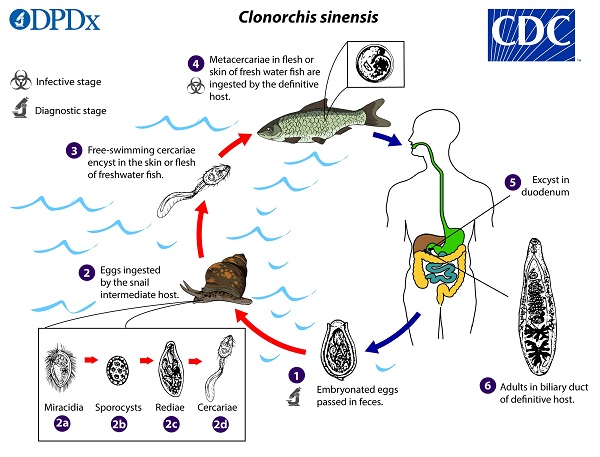Clonorchis sinensis - Life Cycle, Pathogenesis, Pathology, Host Immunity, Clinical Manifestation
Life Cycle of Clonorchis sinensis
The life cycle of Clonorchis sinensis occurs in three hosts- one definitive host and two intermediate hosts.
Definitive host: Several species of wild fish-eating animals as well as dogs, cats, pigs, humans, rat
Intermediate host:
First intermediate host: Freshwater snails of the family Bulindiae.
Second Intermediate host: Freshwater fish of the family Cyprinidae and several species of fresh-water shrimps.
the definitive host acquires infection after consumption of the second intermediate host infected with Clonorchis sinensis metacercaria- freshwater fish of the family Cyprinidae and several species of fresh-water shrimps
* mostly consumption of raw or partially cooked, dried, salted, or pickled
in the host deodenum, the metacercaria excyst
the larvae enter the common bile duct through the ampulla of Vater while moving against the bile flow
it then migrates to the distal bile ducts in the liver where further growth and maturation into adult Clonorchis sinensis worm takes place
adults feed on mucosal secretions
after mating, they began laying embryonated operculated eggs which are passed out along with the host feces
the time between infection by metacercariae and the production of eggs i.e. the pre-patent period is one month
upon reaching freshwater sources such as rivers, lakes, and ponds, further development of the eggs takes place if ingested by the first intermediate host- freshwater snails of the family Bulindiae
in the snail host, the Clonorchis sinensis eggs hatch to release one miracidium larva per egg which penetrates the intestinal wall and reaches the vascular space
the miracidium larvae underdo asexual reproduction by a single generation of sporocysts, two generations of rediae (mother rediae and daughter rediae)
within 3 weeks, a single miracidium larva gives rise to a large number of fork-tailed cercariae
the free-swimming cercariae then escape from the snail into the water and adhere to the second intermediate host - freshwater fish of the family Cyprinidae and several species of fresh-water shrimps
after losing their tail, the cercariae penetrate the skin and reach the flesh or the scale of the fish
in the fish, they encyst to metacercariae within 23 days
the fish infected with Clonorchis sinensis metacercariae if consumed raw, undercooked, dried, salted, or pickled can cause infection in a definitive host such as humans
thus, the life cycle of Clonorchis sinensis is continued for about 3 months

Image: Clonorchis sinensis lifecycle (Source: CDC)
Pathogenesis, Pathology of Clonorchis sinensis
Although the eggs of Clonorchis sinensis cause little to no pathological changes and pathogenesis in the host cells, the migrative larvae and adult worms – dead or alive – can cause pathological lesions in humans.
Pathogenesis, Pathology in the bile duct
a major characteristic feature of Clonorchis sinensis infection is a marked epithelial hyperplasia
live adult worms can cause periductal inflammation, increased mucin production, adenomatous hyperplasia, periductal fibrosis
dead adult worms can obstruct the biliary tract resulting in recurrent pyogenic cholecystitis
in chronic cases, it is associated with cholangiocarcinoma
in rare cases, Clonorchis sinensis may also be present in the pancreatic duct and the gall bladder
Pathogenesis, Pathology in liver
the migrating Clonorchis sinensis larvae may cause conditions such as tender hepatomegaly, mild jaundice, eosinophilia
although the liver tissues show no significant changes, irregularly dilated bile ducts with a layer of fibrous tissue are observed
Host Immunity against Clonorchis sinensis
Host Immunity against Clonorchis sinensis includes the production of circulating specific antibodies in the serum. However, these antibodies do not confer any protection from the fluke parasite.
Clinical Manifestations of Clonorchis sinensis
After an incubation period of 6 weeks to 8 weeks, clinical manifestations of Clonorchis sinensis are observed.
In cases of light infections, the patients remain asymptomatic but can be diagnosed by routine stool examination. In heavy infections, i.e. around 500 to 1000 Clonorchis sinensis, symptoms are seen.
Acute clonorchiasis
Symptoms of acute clonorchiasis caused by Clonorchis sinensis are a serum sickness-like illness with eosinophilia, rash, and high fever.
Chronic clonorchiasis
Symptoms of chronic clonorchiasis, caused by Clonorchis sinensis, include cirrhosis, progressive edema, catarrhal cholecystitis, cirrhosis, jaundice, and tender hepatomegaly.